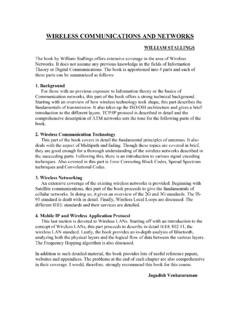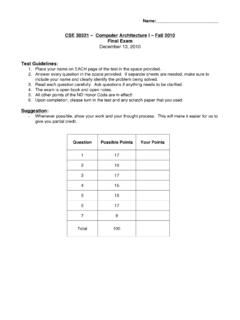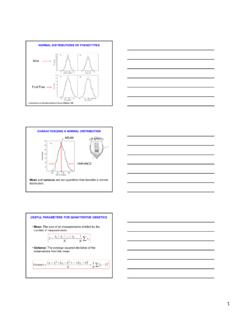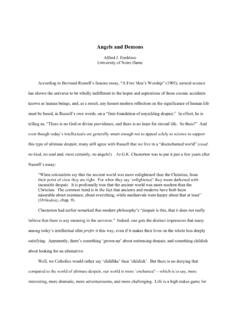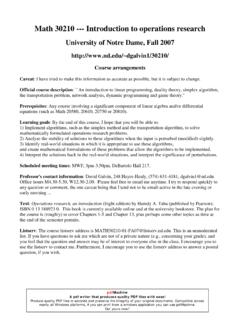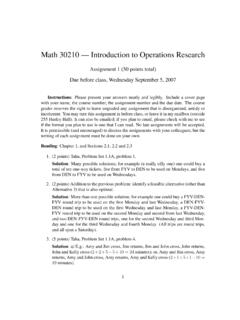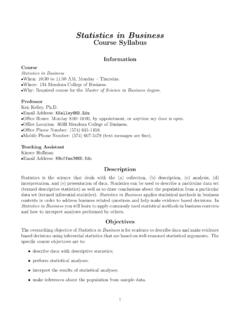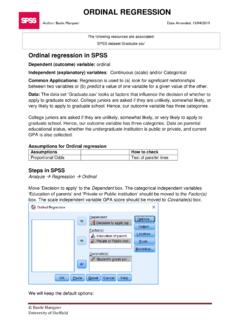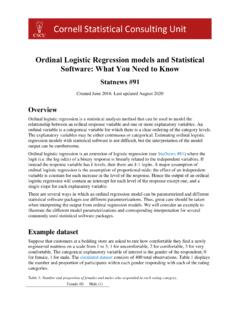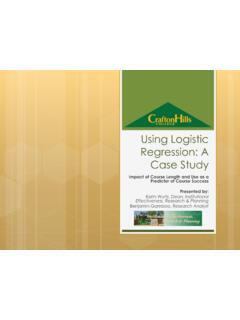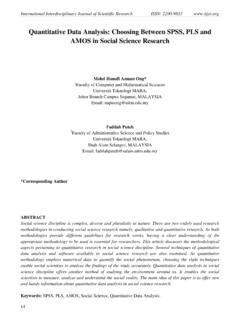Transcription of Ordered Logit Models
1 Ordered Logit Models Basic & Intermediate Topics Page 1 Ordered Logit Models Basic & Intermediate Topics Richard Williams, University of Notre Dame, ~rwilliam/ Last revised February 9, 2021 This is adapted heavily from Menard s Applied Logistic regression analysis; also, Borooah s Logit and Probit: Ordered and Multinomial Models ; Also, Hamilton s Statistics with Stata, Updated for Version 7. For a more detailed discussion with additional examples, see Williams, R. A., & Quiroz, C. (2019). ordinal regression Models . In P. Atkinson, S. Delamont, A. Cernat, Sakshaug, & Williams (Eds.), SAGE Research Methods Foundations. doi: We have talked about the analysis of dependent variables that have only two possible values, lives or dies, wins or loses, gets an A or doesn t get an A.
2 Of course, many dependent variables of interest will have more than two possible categories. These categories might be unordered (doesn t move, moves South, moves East) or Ordered (high, medium, low; favors more immigration, thinks the level of immigration is about right, favors less immigration). We will briefly discuss techniques for handling each of these. ordinal regression As Menard notes, when dependent variables are measured on an ordinal scale, there are many options for their analysis. These include Treating the variable as though it were continuous. In this case, just use OLS regression or the other techniques we have discussed for continuous variables. Certainly, this is widely done, particularly when the DV has 5 or more categories. Since this is probably the easiest approach for readers to understand, sometimes the other approaches are tried just to confirm that the use of OLS does not seriously distort the findings.
3 Ignoring the ordinality of the variable and treating it as nominal. use multinomial Logit techniques like those we will discuss later. The key problem here is a loss of efficiency. By ignoring the fact that the categories are Ordered , you fail to use some of the information available to you, and you may estimate many more parameters than is necessary. This increases the risk of getting insignificant results. But, your parameter estimates still should be unbiased. Treating the variable as though it were measured on an ordinal scale, but the ordinal scale represented crude measurement of an underlying interval/ratio scale. For example, the categories High, Medium, Low might be rough measures for Socio-economic status or intelligence. Ordered Logit Models can be used in such cases, and they are the primary focus of this handout.
4 Menard cautions that choosing the correct option requires careful judgment. In other words, don t just assume that because Stata has a routine called ologit, or that the SPSS pulldown menu for ordinal regression brings up PLUM, that these are necessarily the best way to go. Ordered Logit Models Basic & Intermediate Topics Page 2 Ordered Logit / Proportional Odds Models . Having made that caution, I ll now explain how the Ordered Logit Models estimated by SPSS PLUM and ologit work. The Ordered Logit model fit by ologit is also known as the proportional odds model . The terms parallel lines model and parallel regressions model are also sometimes used, for reasons we will see in a moment. 1. In the Ordered Logit model , there is an observed ordinal variable, Y. 2.
5 Y, in turn, is a function of another variable, Y*, that is not measured. a. In the Ordered Logit model , there is a continuous, unmeasured latent variable Y*, whose values determine what the observed ordinal variable Y equals. b. The continuous latent variable Y* has various threshold points. ( is the Greek small letter Kappa.) Your value on the observed variable Y depends on whether or not you have crossed a particular threshold. For example, when M = 3 Yi = 1 if Y*i is 1 Yi = 2 if 1 Y*i 2 Yi = 3 id Y*i 2 For example, it might be that if your score on the unobserved latent variable Y* was 37 or less, your score on Y would be 1; if your Y* score was between 37 and 53, Y would equal 2; and if your Y* score was above 53, Y would equal 3. Put another way, you can think of Y as being a collapsed version of Y*, Y* can take on an infinite range of values which might then be collapsed into 5 categories of Y.
6 3. So, what does Y* equal? How do you estimate this model ? a. In the population, the continuous latent variable Y* is equal to =+=+=KkiiikikiZXY1* Note that there is a random disturbance term, which, in this case, has a standard logistic distribution (mean of 0 and variance of ; a N(0, 1) distribution is also often used). This reflects the fact that relevant variables may be left out of the equation, or variables may not be perfectly measured. b. The Ordered Logit model estimates part of the above: )*(1iKkkikiYEXZ== = c. Note that, because of the random disturbance term, the unmeasured latent variable Y* can be either higher or lower than Z. By way of analogy, the typical person with 12 years of Ordered Logit Models Basic & Intermediate Topics Page 3 education might make $30,000 a year; but any specific person with 12 years of education may make more than that or less than that.
7 Because of the disturbance term, because Z is not a perfect measure of Y*, you will incorrectly classify some cases as falling within one range when they actually fall within another. But, because you know the distribution of the error term, you can also estimate what the probability of error is. d. The K s and the M-1 s are parameters that need to be estimated. Once you have done so, using the corresponding sample estimates for each case you compute ==KkkkiXZ1 Note that there is no intercept term. You then use the estimated M-1 cutoff terms to estimate the probability that Y will take on a particular value. OPTIONAL: The formulas are exp()(), j 1 , 2, .., M 11 [exp()]ijiijXPYjX >== + , which implies 111111exp()(1) 11 [exp()]exp()exp()()2.
8 ,11 [exp()] 1 [exp()]exp()()1 [exp()]iiiijijiijijiMiiMXPYXXXPYjjMXXXPY MX = = + == = + + = =+ In the case of M = 3, these equations simplify to )exp(11 1)3()exp(11 )exp(11)2()exp(11)1(2121 + == + +== +==iiiiZYPZZYPZYP 4. Hence, using the estimated value of Z and the assumed logistic distribution of the disturbance term, the Ordered Logit model can be used to estimate the probability that the unobserved variable Y* falls within the various threshold limits. Ordered Logit Models Basic & Intermediate Topics Page 4 NOTE: As Long points out, you can also motivate the Ordered Logit model by thinking of it as a nonlinear probability model , you predict the probability of a 1, a 2, etc. You don t have to rely on the notion of an underlying y*, and some prefer not to.
9 Example. In Statistics With Stata, Updated for Version 7, Hamilton presents a fascinating example that shows that the space shuttle Challenger disaster of January 28, 1986, might have been averted had NASA officials heeded the warning signs. Data cover the first 25 flights of the space shuttle. For each flight, the following variables are measured: Distress The number of thermal distress incidents in which hot gas damaged the joint seals of a flight s booster rockets. Damage to the joint seals helped lead to the Challenger disaster. This is the DV. It is coded 1 = None, 2 = 1 or 2, and 3 = 3 plus. Temp The calculated joint temperature at launch time. Temperature depends largely on weather. Colder temperatures cause the rubber o-rings sealing the booster rocket joints to become less flexible and hence more likely to have problems.
10 Date Date, measured in days elapsed since January 1, 1960 (an arbitrary starting point). The rationale for this variable is that undesirable changes in the shuttle program and aging hardware may have caused launches to become more risky across time. Here is the data: flight distress temp date z (computed) 1 none 66 7772 2 1 or 2 70 7986 3 none 69 8116 4 MISSING 80 8213 5 none 68 8350 6 1 or 2 67 8494 7 none 72 8569 8 none 73 8642 9 none 70 8732 10 1 or 2 57 8799 11 3 plus 63 8862 12 3 plus 70 9008 13 none 78 9044 14 none 67 9078 15 3 plus 53 9155 16 3 plus 67 9233 17 3 plus 75 9250 18 3 plus 70 9299 Ordered Logit Models Basic & Intermediate Topics Page 5 19 1 or 2 81 9341 20 1 or 2 76 9370 21 none 79 9407 22 3 plus 75 9434 23 1 or 2 76 9461 24 3 plus 58 9508 25 (Challenger) MISSING 31 9524 Here is what Stata s ologit gives you when Distress is regressed on Date and Temp.
